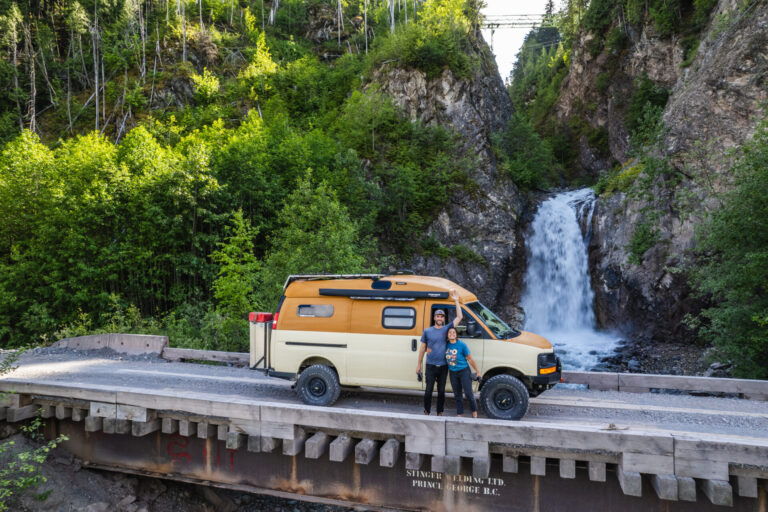
We’ve all seen the glamorous advertisements on our screens. Glossy trucks with shiny rims and big knobby tires, big shocks and aggressive bumpers ripping through the deserts and mountains, mud, dust and sand pluming from the wheel wells. You NEED these shiny things to go off-road, you NEED 4×4 to go on a real adventure. We’ve been trained to think that there is this massive bar to entry to get out and enjoy the backroads of North America. Well, I’m here to tell you that’s just not the case.
About Overlanding with a 2WD
Hey there, it’s Alex, your friendly neighborhood van overlander. Admittedly, I’ve been on a bit of a conquest for some time, trying to educate people on how little they need to actually get out and do vanlife or overland travel. I’m often a little bewildered by the number of people I meet along my travels that believe that they need something like we drive, or something like what they think we drive (we drive a jacked up 2WD delivery van it’s NOT 4wd), to get out on the trail. Our vehicle of choice and the way that it’s been modified isn’t necessarily the embodiment of my message, but that’s mainly because we push our vehicle well beyond the purpose of which it was intended for. All the talk about big tires, big suspension and big bumpers aside, I want to focus on the common belief that you NEED 4×4 to go on an off-road adventure.
I chuckle to myself when I see how often the term “off roading” is used. By the literal definition, off-roading is the travel over a surface without a road, which is basically illegal in most states in the US and frowned upon everywhere else. So, is anyone truly off-roading? With that being said, off-roading now just defines anything off-pavement. At this point, instead of boring you with a long explanation of different road surfaces and what is needed to traverse said surfaces, I want to share a story of an adventure we recently had in our two wheel drive van. I think what we accomplished is a prime example of the point I’m trying to convey.
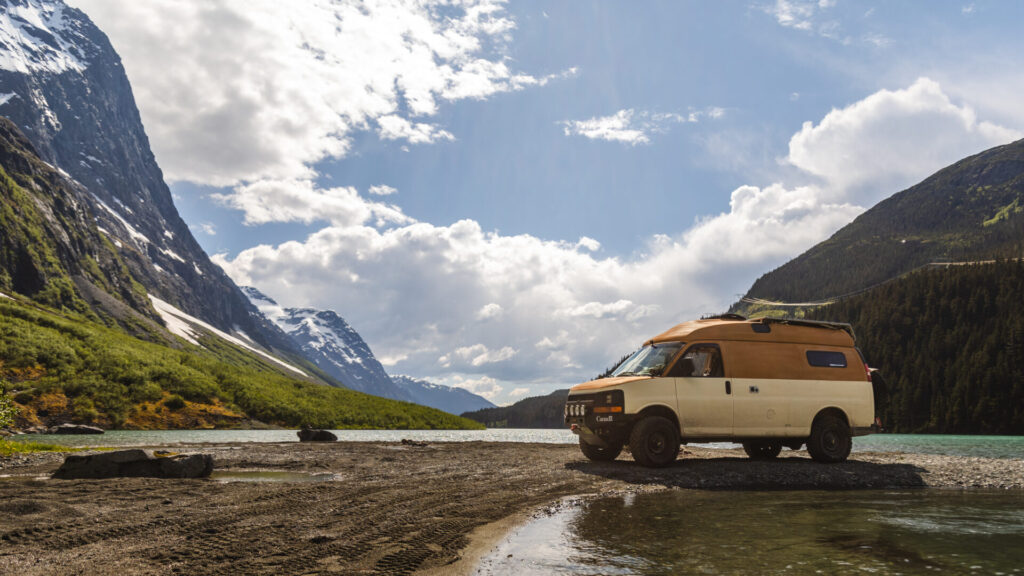
Overlanding Northwest Territory, Canada
Currently, my partner, Megan, and myself are on our way up to Tuktoytaktuk, Northwest Territory, Canada to start the Pan American highway. We started our trip from the northern tip of Vancouver Island, leaving on a ferry that took us from Port Hardy all the way to Prince Rupert. Upon leaving the terminal we arrived in Prince Rupert, British Columbia sixteen hours and 274 nautical miles later. Prince Rupert is located within the maze of islands and waterways that make up the British Columbia coast and immediately after leaving the town you’re surrounded by towering coastal mountains. Following the impressive Skeena River inland you eventually get to Terrace, BC and just outside of Terrace is where our adventure really began. I had my eyes on a stretch of trail called the Telkwa Pass that goes from just outside Terrace, through a mountain range to Telkwa, BC.
Telkwa Pass
Back in 2017 on another trip through northern Canada and Alaska I had stopped off with a friend in Smithers, BC and he had told me about the Telkwa Pass. Due to weather and inexperience at the time, I opted not to do the trail, but kept it at the back of my mind for seven years. Even though I returned with a 2WD vehicle that was less capable than the 4×4 Tacoma I had previously, I wasn’t going to miss the opportunity to explore this incredible region this time around. Being a YouTuber myself, I had watched two fellow video creators explore the area ahead of me the year previous. Both of them are vanlifers, one with a capable 2WD van and the other a 4WD van. They had gone in opposing directions and the one with a 2WD van had turned around at an obstacle he deemed impassable for his van. My knowledge of the trail aside from this was pretty sparse. It seemed that, for anyone driving the trail with a smaller 4WD vehicle, be it a side by side, quad or small pickup, the trail was pretty easy. As far as I could tell, no 2WD van had completed the whole trail.
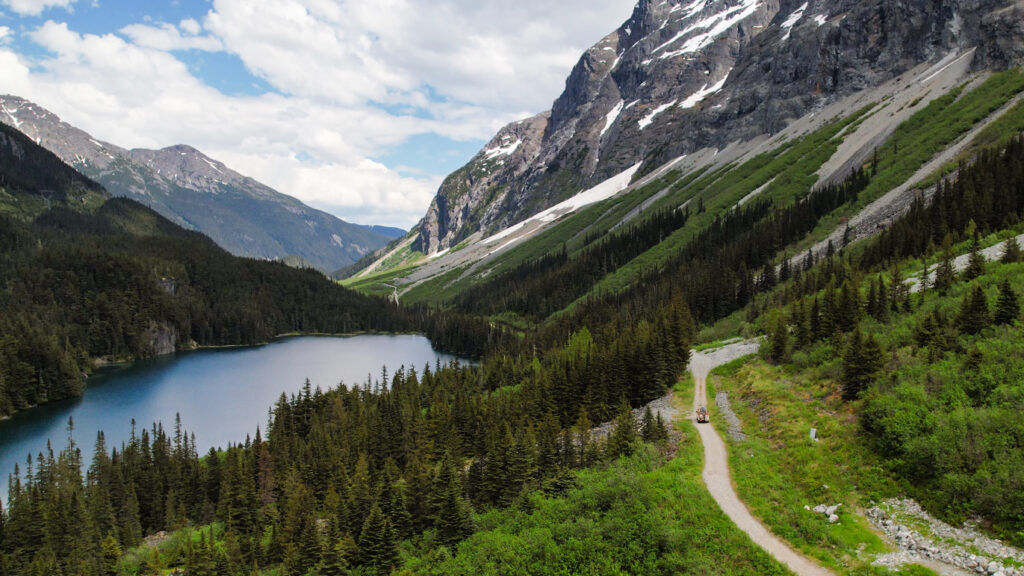
Shortly after leaving Terrace, we pulled off onto the FSR (forest service road) that would take us into the mountains. We plunged into a world of tree tunnels, peak-peeking, waterfalls and rivers. Driving for an hour and a half along the Copper Mountain River we eventually found our camp spot for the night, a level sandbar not three meters from the river. We nodded off to sleep listening to the constant rush of distant rapids, night only dipping to total darkness for a couple of hours. The next morning we finished off our online work quickly, ate breakfast by the river and then set off. It was going to be a big day of travel and adventure. Slowly but surely the road began to climb in elevation. The mountains continued to grow taller and eventually we could see snow capped peaks in all directions. The road remained in decent shape for most of the way, potholed, but decent. About two hours of driving later we had arrived at the beginning of the actual trail section. This is where the road narrows and begins to wind, climb and descend steeply as it traverses the mountain’s base. Trail conditions were good, not much mud, some deep puddles and shallow creek crossings. Kilometer by kilometer the mountains at our sides grew closer until they loomed over us like giant sentries.
Telkwa Pass with a 2WD
Another hour in I was feeling pretty confident. We hadn’t come up against anything that had really challenged us, we’d made it past all the tight sections, small inclines and through all the water crossings. Easy peasy! But, then we reached where the fellow creator with the 2WD van had turned around. A long, steep and winding climb accented with a water bar (a small dug out for water to cross the road) at the base and lots of big loose rock. I was pretty skeptical…but I’m also foolhardy and unreasonably driven to complete what I start. Momentum is an incredible thing, if you can maintain it, it’ll get you through a lot. In an off-road situation, if you’re using momentum to tackle an obstacle, you need to walk the line of maintaining as much momentum as possible without damaging the vital components of the vehicle you’re piloting. In this case, I would need to carry enough momentum up the hill to get me through the initial water bar obstacle without destroying my front suspension and then carry enough afterwards to propel us up the steep incline and over the large, loose rock. I looked at the hill for all of 10 seconds and then went for it.
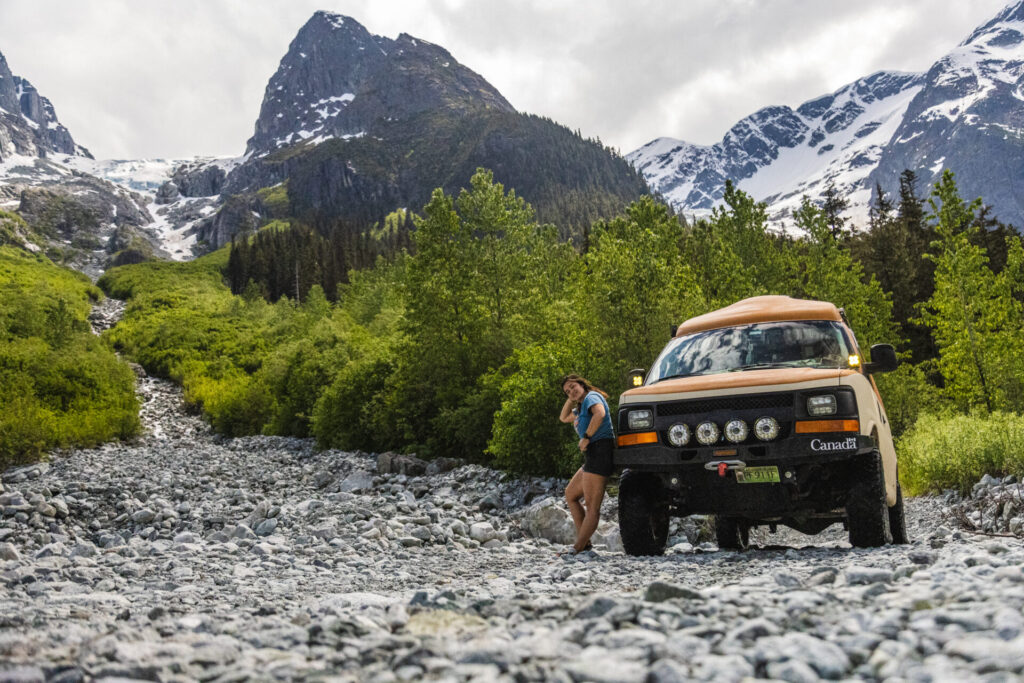
The worst thing that could happen in my opinion was getting stalled on the hill and having to back down. I gathered momentum on the small hill prior to starting up the incline and kept my foot on the gas, modulating the throttle until the point at which all I could do was have it mashed on the floor. To my utmost surprise, the van powered through and continued to climb right to the top. I was astonished and also dumbfounded by the view we got as a reward. What we saw at the top would have most people thinking, “we’ve made it” as it did us, but we still had another 5km to go. That last 5km was by far the most aggressive and challenging off-roading we’ve ever done in the van. Not long after the first incline we encountered another even steeper climb that we barely made it up, after which were numerous rock gardens, a rock slide that we needed to winch boulders out of the way and tree tunnels so narrow that we thought our solar panels and awning would be ripped off.
After six hours on the trail we finally arrived at our camp spot for the next two nights. When I tell you this spot is the spot of legend, I am being completely truthful and objective. There are not a lot of spots like this that you can drive a vehicle to, much less a 2WD vehicle. At the base of a massive mountain with three glacier fed water falls, on a sandbar jutting out into a crystal clear lake we made home. It was…epic.
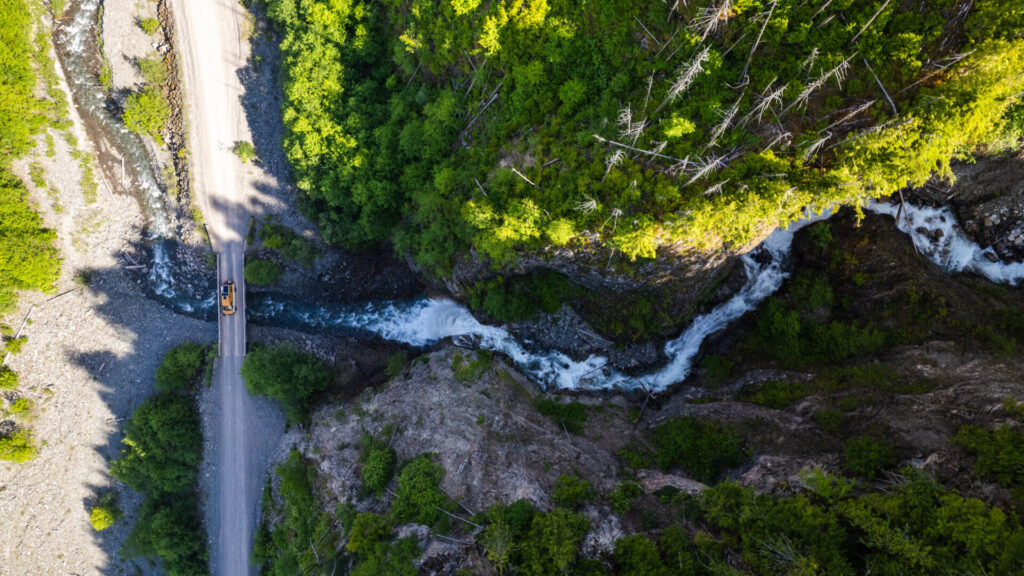
Before You Go Overlanding with a 2WD Van..
Let’s look at the reality of this situation for a moment before I leave you with aspirations of smashing through rocks and trees with your big RV or 2WD van. We proved that this epic lake spot could be accessed by 2WD. Is it advisable to do so…? Probably not. There were enough times that I thought that we might burn up our transmission that I would most definitely advise against doing this trail with anything less than a transfer case and locker. Yes, we did the trail without a transfer case, I can say we did it, but as mentioned previously, I’m a little fool hardy. So, as a disclaimer, don’t try to make it here in a 2WD van; however, I think our case proves well enough that you most certainly don’t need a 4WD vehicle with all the doo-dads to get out and have an adventure. In fact, it’s a growing opinion of mine that you can have more fun in a 2WD vehicle because the bar to entry for a good thrill is lower. Everyone we encountered on the trail, either driving a side by side, quad or pickup all down-played how difficult the trail was. It was, for them, easy and nonchalant. For us, it was at times an epic struggle just to get up a hill.
So, to conclude this little tale/rant of mine, take your 2WD van somewhere that makes you nervous, maybe you’ll be surprised by how much further you’ll go. Remember that, those FSR’s or long, gravel desert tracks are driven by cars and service vehicles all the time, just because it’s gravel and has bumps doesn’t mean you’ll spin out of control and be hopelessly stuck. And if you do get stuck, embrace the experience and look forward to telling the tale one day when you’re through on the other side. Your adventure is out there, no matter how big or small it may look to others and the bar to entry is often lower than you think.






